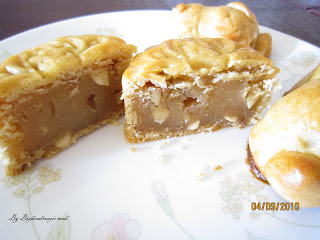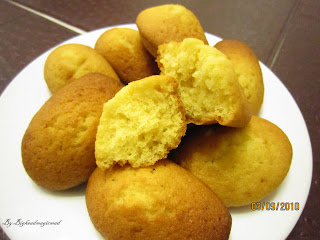

This is my 3rd attempt of making char siew pau in a week.
I'm so happy! Finally I got the texture that I want. I think adding baking powder play the trick, that made the pau soft and light texture.
The long slow fermentation of the yeast dough, that help the pau stay soft even when it turn cold.
Here is my new recipe.
Ingredients:
Yeast Dough Ingredient:
300 g Hong Kong flour
1 tsp instant yeast
150 ml water
1/2 tsp of salt
To make Yeast Dough
Mix flour, yeast, water and salt together. Just like the No Knead Method. Transfer it into a plastic bag and keep it in the fridge and leave it to rest for at least 15 hours.
Filling Ingredients:
4 chicken drum sticks, cut to small pieces
1 tbsp minced garlic
4 to 5 shallots sliced
1 tbsp of hosin sauce
1/2 tbsp soya sauce
2 3/4 tbsp sugar
1/2 tsp dark thick soya sauce
1 tbsp oyster sauce
1 tbsp tapioca flour diluted with 2 tbsp water
1/4 cup chopped fresh cilantro/ spring onion
1 tsp sesame oil
Method:
To make Filling:
Cut chicken into tiny dices, mix with hosin sauce, soya sauce, sugar, oyster sauce and dark sauce.
Heat wok with a little oil and add in the minced garlic, sliced shallot. Saute until fragrant and add the chicken meat, continue to cook until chicken is well done. Add the tapioca flour and water mixture. Cook until sauce comes back to the boil and thicken.
Add in chopped cilantro or spring onion and drizzle with sesame oil.
Leave to cool.
To make Pau Dough Ingredients:
150 g Hong Kong flour
1 tsp double action baking powder
3 tbsp sugar
1/2 tbsp shortening
1 tbsp water
1 tsp ammonium bicarbonate
2 tiny drops kan sui(akaline water/potassium carbonate & sodium bi-carbonate solution)
To make Pau Dough after 15 hours:
Sieve the baking powder with the flour.
Mix ammonium bicarbonate, kan sui(akaline water) and water and mix until ammonium bicarbonate is dissolved.
Tear up the yeasted dough into small pieces and place in a bowl, add in the sugar, shortening and the ammonium bicarbonate solution. Knead until well mixed, Add in flour and knead the dough until it is smooth.
Divide dough into portions. Line the divided dough up. Start from the first portion, cup the dough portion with your palm and round it. Repeat with the rest of the portions, lining them up in order.
While making the paus, fill steamer pot with water and bring to the boil.
Roll the first rolled portion dough out into a circle and fill with a tablespoon of cooled filling. Pleat the circle up and seal well. Roll the circle bigger, so that you can have more dough on top of pau. Put a piece of paper at the base of pau and leave in a steamer rack, covered with a damp cloth while you prepare another paus.
Make sure water is in a rolling boil before putting the steamer rack with the prepared paus to steam for 10 minutes, if you are making bigger paus, then steaming time will be longer.
Continue to wrap paus with the char siew filling and steam.
These paus cannot be consumed yet as they stink from the ammonium bicarbonate. A second steaming of 10 minutes is required to allow the ammonium to dissipate.
Enjoy the paus warm.
Please see Lilyng Blog, if you like the original smiling Char Siew Pau
http://lilyng2000.blogspot.com/2010/01/oyster-sauce-char-siew-pau.html






